
The Chetniks, formally the Chetnik Detachments of the Yugoslav Army, and also the Yugoslav Army in the Homeland and the Ravna Gora Movement, was a Yugoslav royalist and Serbian nationalist movement and guerrilla force in Axis-occupied Yugoslavia. Although it was not a homogeneous movement, it was led by Draža Mihailović. While it was anti-Axis in its long-term goals and engaged in marginal resistance activities for limited periods, it also engaged in tactical or selective collaboration with Axis forces for almost all of the war. The Chetnik movement adopted a policy of collaboration with regard to the Axis, and engaged in cooperation to one degree or another by both establishing a modus vivendi and operating as "legalised" auxiliary forces under Axis control. Over a period of time, and in different parts of the country, the movement was progressively drawn into collaboration agreements: first with the puppet Government of National Salvation in the German-occupied territory of Serbia, then with the Italians in occupied Dalmatia and Montenegro, with some of the Ustaše forces in northern Bosnia, and, after the Italian capitulation in September 1943, with the Germans directly.

Dragoljub "Draža" Mihailović was a Yugoslav Serb general during World War II. He was the leader of the Chetnik Detachments of the Yugoslav Army (Chetniks), a royalist and nationalist movement and guerrilla force established following the German invasion of Yugoslavia in 1941.
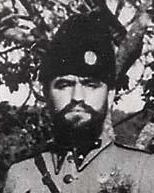
Momčilo Đujić was a Serbian Orthodox priest and Chetnik vojvoda. He led a significant proportion of the Chetniks within the northern Dalmatia and western Bosnia regions of the Independent State of Croatia (NDH), a fascist puppet state created from parts of the occupied Kingdom of Yugoslavia during World War II. In this role he collaborated extensively with the Italian and then the German occupying forces against the communist-led Partisan insurgency.
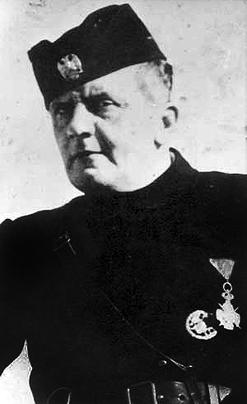
Dobroslav Jevđević was a Bosnian Serb politician and self-appointed Chetnik commander in the Herzegovina region of the Axis-occupied Kingdom of Yugoslavia during World War II. He was a member of the interwar Chetnik Association and the Organisation of Yugoslav Nationalists, a Yugoslav National Party member of the National Assembly, and a leader of the opposition to King Alexander between 1929 and 1934. The following year, he became the propaganda chief for the Yugoslav government.
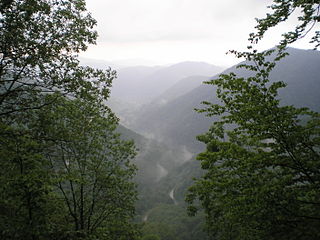
The Operation Kopaonik was a large-scale Axis offensive launched against the Mihailović's Chetniks in Axis occupied Yugoslavia during World War II. The operation was inspired by Heinrich Himmler who believed that the annihilation of Draža Mihailović and his forces was a basis for a success in Serbia and South East Europe. Since Dragutin Keserović and his Rasina Corps was probably the most active commander of Mihailovićs Chetniks in Serbia, the newly established 7th SS Volunteer Mountain Division Prinz Eugen was engaged to participate in Operation Kopaonik to destroy Keserović and Chetnik unit under his command.

Vojislav Lukačević was a Serbian Chetnik commander in the Kingdom of Yugoslavia during World War II. At the outbreak of war, he held the rank of captain of the reserves in the Royal Yugoslav Army.

Lieutenant Colonel Zaharije Ostojić was a Montenegrin Serb and Yugoslav military officer who served as the chief of the operational, organisational and intelligence branches of the Chetnik Supreme Command led by Draža Mihailović in Yugoslavia during World War II. He was a major in the Royal Yugoslav Army Air Force prior to the Axis invasion of Yugoslavia, and was involved in the coup that deposed Prince Paul of Yugoslavia on 27 March 1941. After the coup, he escorted Prince Paul to exile in Greece, and was in Cairo during the invasion in April. In September 1941, he was landed on the coast of the Italian governorate of Montenegro along with the British Special Operations Executive officer Captain Bill Hudson and two companions. He escorted Hudson to the German-occupied territory of Serbia and introduced him to the Yugoslav Partisan leader Josip Broz Tito at Užice, then accompanied Hudson to Ravna Gora to meet Mihailović. Ostojić soon became Mihailović's chief of staff, and after the German attempt to capture the Chetnik leader during Operation Mihailovic in December 1941, brought the Chetnik Supreme Command staff to Montenegro where they were re-united with Mihailović in June 1942. During the remainder of 1942, Ostojić launched a counter-attack against Ustaše troops of the Independent State of Croatia returning to the eastern Bosnian town of Foča where they were expected to continue their genocidal anti-Serb policies. As many as 2,000 local Muslims were subsequently killed in the town by forces under Ostojić's command. Ostojić later oversaw large-scale massacres of civilians and burning of Muslim villages in the border region between Montenegro and the Sandžak.
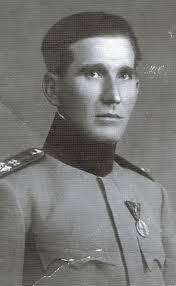
Dragutin Keserović was a Yugoslav Chetnik military commander holding the rank of lieutenant colonel and vojvoda during World War II. Keserović was likely the most active commander of Mihailović's Chetniks in Serbia.

Đorđije Lašić was a Montenegrin Serb military officer of the Royal Yugoslav Army. During the Second World War he participated in the 1941 Uprising in Montenegro, but has soon turned to collaboration with Axis occupation forces until 1944, when he was killed during the bombing of Podgorica.
Boško Todorović was a Chetnik commander and delegate of the Chetnik leader Draža Mihailović in eastern Bosnia during World War II. During the interwar period he was a major in the Royal Yugoslav Army. Following the April 1941 Axis invasion of Yugoslavia he joined Mihailović's Chetnik movement. Initially considered a moderate, he was responsible for negotiating the transfer of parts of eastern Bosnia from Italian to Chetnik administration in November 1941, after which the Chetniks massacred hundreds of Muslim civilians in the region. He also signed a collaboration agreement with the Italians to protect the Serb population in Italian-occupied areas. He was killed by the Yugoslav Partisans in February 1942, either trying to evade capture, or he was executed after a brief trial when captured in possession of compromising documents regarding collaboration with the Italians.
Operation Bullseye was the code-name of the first Special Operations Executive (SOE) mission to Yugoslavia since its occupation by the Axis forces. It was led by Capt D.T. Bill Hudson with the objective to discover what was happening in Yugoslavia and co-ordinate all forces of resistance there. The mission also included three Royal Yugoslav Army (RYA) officers from Montenegro: Maj Mirko Lalatović, Maj Zaharije Ostojić and Sgt Veljko Dragićević the wireless transmitter (W/T) operator. The group boarded the submarine HMS Triumph in Malta and reached Petrovac on the Montenegrin coast on 20th Sep 1941.

Miloš Glišić was Yugoslav military officer.

Velimir Piletić was a Yugoslav military officer, best known as commander of the Chetnik forces in eastern Serbia during World War II.
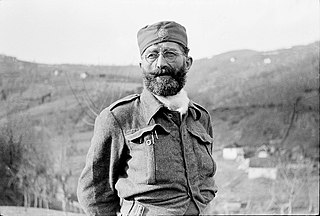
The Ba Congress, also known as the Saint Sava Congress or Great People's Congress, was a meeting of representatives of Draža Mihailović's Chetnik movement held between 25 and 28 January 1944 in the village of Ba in the German-occupied territory of Serbia during World War II. It sought to provide a political alternative to the plans for post-war Yugoslavia set out by the Chetniks' rivals, the communist-led Yugoslav Partisans, and attempted to reverse the decision of the major Allied powers to provide their exclusive support to the Yugoslav Partisans while withdrawing their support of the Chetniks.

Robert Harbold McDowell was an American historian and intelligence officer who worked for the Office of Strategic Services (OSS) during World War II. McDowell, an expert on the Near East, was a professor of Balkan history at the University of Michigan. During World War II he was an OSS desk officer in Cairo and between August and November 1944 a member of an American mission Ranger, to the Chetniks, where he participated in negotiations with Germans to surrender their troops to Chetniks and Americans, and in Operation Halyard, to organize transport of the Allied pilots rescued by Chetniks. In some works he has been described as a man of "violently pro-Chetnik prejudices".

Brigadier Charles Douglas Armstrong was a British Army officer in World War I and World War II. In the latter conflict he was the head of the British Special Operations Executive (SOE) liaison mission to the Chetnik forces of Draža Mihailović in Yugoslavia from July 1943 to early 1944.
The Battle of Višegrad was the battle between Chetnik forces and Axis, and part of an Chetnik offensive in Eastern Bosnia in autumn of 1943, in Axis occupied Yugoslavia during World War II. The Chetnik forces of 2,500 captured Višegrad, destroyed big railway bridge across river Drina and continued their advances toward Rogatica and Sokolac. The German and Ustaše garrison in Višegrad and garrison that protected the bridge of total 1,100 soldiers had 350 dead and 400 wounded. The Chetniks had 21 dead and 30 wounded. In subsequent battle for Rogatica waged ten days later, the Chetniks captured Rogatica and killed more than 200 Axis soldiers.
Stanley William Bailey was a British Army officer in World War II, who reached the rank of colonel and was most notable for being the head and then political advisor of the British Special Operations Executive Liaison Mission to the Chetnik Forces of Draža Mihailović from December 25, 1942—January 29, 1944. British policy toward Mihailović was shaped by the regular reports from Bailey. Bailey's position on General Mihailović was influential in undermining the relationship between Mihailović and the Chetniks with Churchill and the British Foreign Office, and consequently with the other Allied nations.

The attack on Kruševac was an attack of Yugoslav rebels on Axis-held Kruševac in the German-occupied territory of Serbia which lasted between 23 and 27 September 1941 during World War II.
Vuk Kalaitović was a Yugoslav military officer holding the rank of captain who was commander of the Chetnik Mileševa Corps during World War II.















